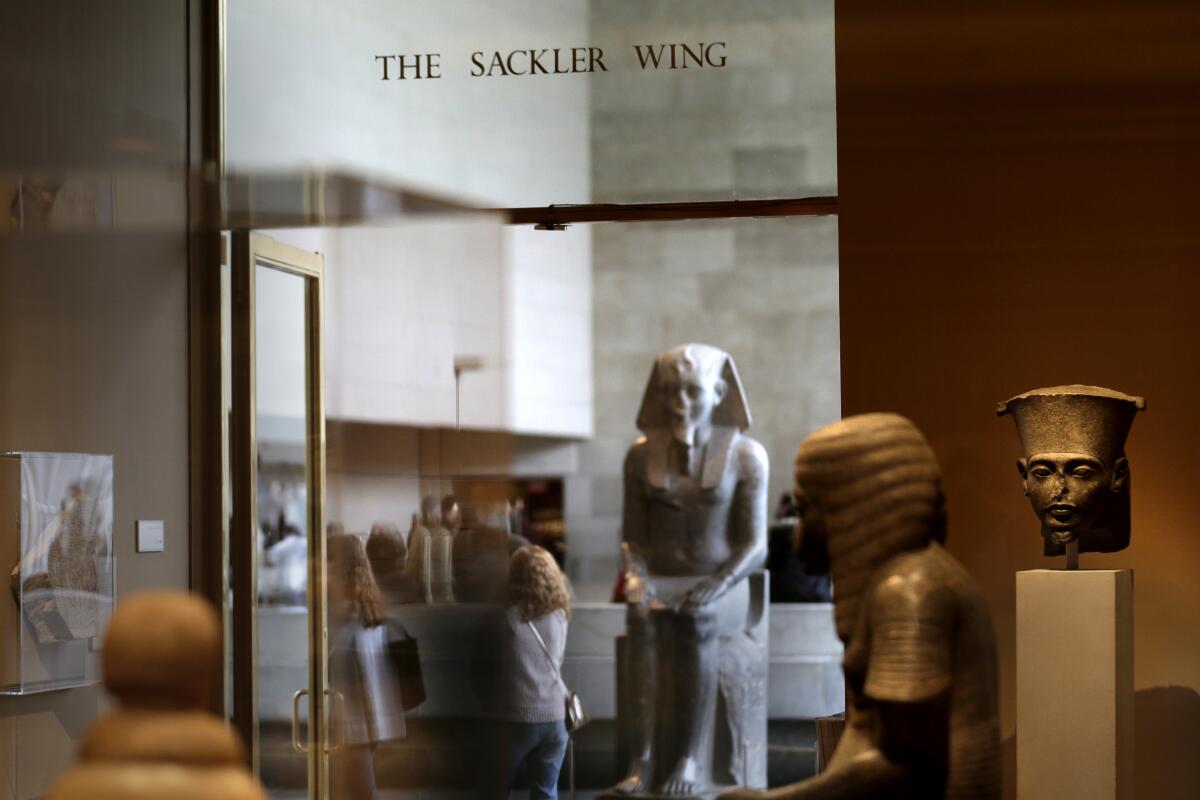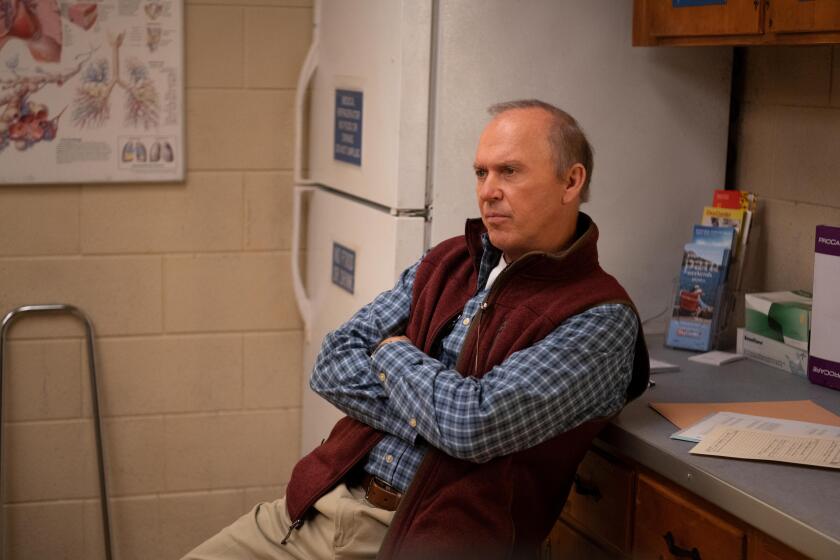Op-Ed: The Met’s decision to drop the Sackler name is a reminder donors aren’t separate from their deeds

- Share via
It was a supreme moment of addition by subtraction. On Dec. 9, the Metropolitan Museum of Art announced an agreement with representatives of the Sackler family to remove the Sackler name from “seven named exhibition spaces in the Museum, including the wing that houses the iconic Temple of Dendur.”
The Sacklers have been one of the best known philanthropic dynasties of the last half-century. Over the last several years, they have also become better known as the owners of a company, Purdue Pharma, that manufactured and vigorously promoted Oxycontin, a painkiller that helped to spark the opioid crisis.
The move to ax the Sackler name from exhibition spaces in the museum comes amid growing outrage over the family’s alleged role in the opioid crisis.
The Met’s announcement was the culmination of a campaign led by the photographer Nan Goldin — who was previously addicted to opioids and survived an overdose — and her advocacy group Prescription Addiction Intervention Now (PAIN) to pressure cultural institutions into dropping the Sackler name. PAIN staged its first protest in March 2018 at the Met — with activists tossing pill bottles into the reflecting pool in the museum’s Sackler wing — and soon took on other museums, some of which agreed to cut associations with the family. The Met even promised in May 2019 to refuse any future donations from the Sacklers.
But those names remained etched on the museum’s walls — until now.
The Sacklers represent a somewhat exceptional case; for much of the last several decades, few other families could claim such a chasm between their burnished public identity as celebrated benefactors and the sordid reality of how their fortune was made. But the Sackler saga can remind us of the importance of minding the gap between the two realms of capitalist accumulation and philanthropic redistribution.
Since the dawn of modern philanthropy in the late 19th century, concentrated wealth has been legitimized by the potential to give some of it away, even as such gifts helped obfuscate the means by which the money was made. As prescribed by Andrew Carnegie’s 1889 “Gospel of Wealth” essay, since embraced by generations of philanthropists, what mattered most was the intelligence and skill with which wealth was redistributed to the public by the dedicated “steward.”
So in 1892, soon after Carnegie’s surrogate had brutally suppressed a strike in a Homestead, Penn., steel mill, Carnegie faced local opposition over a donation he made to fund a library, music hall and art gallery in Pittsburgh — then responded by insisting on the need “to separate the donor and his many faults” from his gifts, “which have none.”
The limited series starring Michael Keaton and Rosario Dawson weaves culpability of big pharma with opioid addicts and law enforcement.
This logic clearly appealed to many business leaders and benefactors, who didn’t particularly want the public snooping around their “faults” and who might have seen in philanthropy an opportunity for what is now termed “reputation laundering.” But it also held allure for fundraisers and boards at charitable institutions that depended on large donations, and who preferred not to have their solicitations encumbered by inconvenient questions about the source of donations.
Of course, the logic was unlikely convincing to the men and women who protested those Carnegie-funded institutions in Pittsburgh. Their presence in the story highlights a force which has tracked large-scale philanthropy as it has surged at different periods, including recent decades: a critical public that weighs philanthropy’s benefits against its costs in justifying concentrated wealth and suspect business practices.
Leading those efforts have often been those who patronize institutions which rely on philanthropy, as well as those whose lives have been most profoundly shaped (or misshaped) by the businesses that produced philanthropy-fueling wealth. The Met’s decision is the crowning achievement of that public.
For nonprofit institutions, the Met’s decision will perhaps lead to a more cautious approach to granting naming rights. It is likely, for instance, that the news will encourage a burgeoning trend toward incorporating time limits into naming rights agreements (it was a 20-year limit on naming rights that allowed the Louvre to remove all traces of the Sackler name in July 2019, becoming the first major cultural institution to do so).
Some have encouraged time-limit provisions as a way to guarantee a renewable philanthropic resource for nonprofits. In fact, the Sacklers and the Met gestured toward this rationale in announcing the name removal, framing it as a “gracious gesture” on the family’s part that “pass[ed] the torch” to a new generation of benefactors who could pony up for naming rights.
Overdose deaths are skyrocketing in the U.S. and the increases are not being felt equally.
The Met’s decision might also convince some of the holdouts who still bear the Sackler name — the Guggenheim, Yale, Oxford and the National Gallery in London among them — to take it down.
Even more broadly, this latest development will hopefully encourage charitable institutions to think more carefully about the relationship between their mission and the source of the philanthropic dollars they solicit to support it. In the face of unrelenting pressure to bring in more dollars, fundraisers and boards need to reflect on who they are honoring, and who they might be dishonoring, by accepting certain large-scale donations.
What might donors learn? The recent decision of the Met and the protests that prompted it have not entirely revoked the license that grand philanthropic gestures have historically given to wealthy individuals to condone or commit corporate misdeeds. But they are a reminder that, contra Carnegie, the public is paying more attention to connections between donors, their faults and their gifts. And so in the future, we can only hope that the erasure of the Sackler name will lead some prospective benefactor to act more scrupulously in the heat of the corporate moment.
Benjamin Soskis is a senior research associate at the Urban Institute’s Center on Nonprofits and Philanthropy.
More to Read
A cure for the common opinion
Get thought-provoking perspectives with our weekly newsletter.
You may occasionally receive promotional content from the Los Angeles Times.













